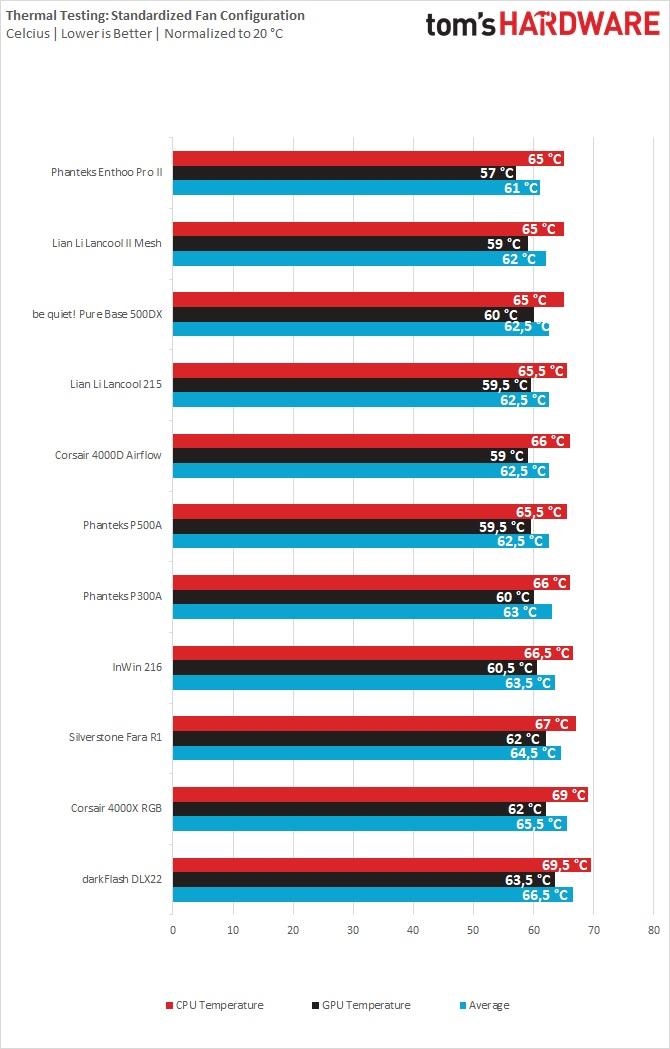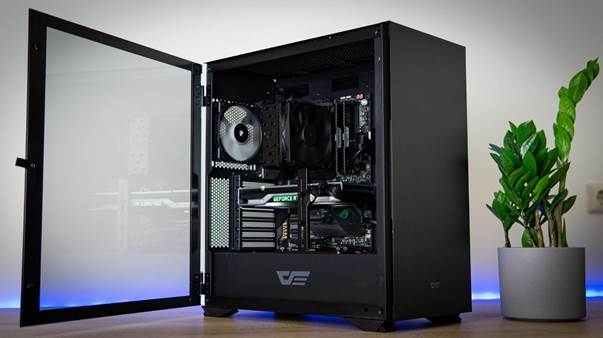Why you can trust Tom's Hardware
For thermal and acoustic testing, we are using the following software and settings:
| CPU Clock | i9 9900k: 4.6 GHz (46x 100MHz) @ 1.1v |
| GPU Clock | RTX 2070 Super: Stock |
| GPU Driver | Nvidia GeForce 445.87 |
| Case & CPU Fan Speeds | Stock Configuration 100% |
| Row 4 - Cell 0 | Standardized CPU 100% |
| Row 5 - Cell 0 | Case fans 50%. |
| GPU Fan Speeds | 75% |
Acoustic Results
Because this case doesn’t come with any fans from the factory, we’re skipping the stock test suite and jumping straight to the standardized tests with the Corsair ML fans.
Standardized Results
To correct for differences in case fans, for the standardized test we use Corsair ML120 or ML140 units. Up to three fans may be installed, preferably one at the default exhaust location and two at the front intake, in the biggest sizes the case supports to reward cases with big fan mounts.
The fan speeds used are maximum on the CPU fan, 50% duty on the Corsair ML fans (higher speeds should never be necessary and are far too loud), and the RTX 2070 Super GPU runs at 75% duty. For the optimized idle scenario all fans have to spin at the lowest speed they will run at.


As I started testing, one thing that was immediately clear was that one of the fans in the system was running too fast -- or so I thought. I checked over all, but couldn’t find the culprit, until I got to the GPU. The peg holding the GPU up was causing turbulence with the fan, making it much louder than it needs to be. I tried to move the bracket away from the fan, but it did not have a wide enough range of adjustments, so the noise figures came out louder than they should, especially for a closed-front chassis.
This sounded very ‘whiny,’ as if the fan had a broken bearing. This made the GPU noisy when idling, and especially when the GPU fan speeds went up, the noise level was much higher than every other case we’ve tested.
Thermally, it will come as no surprise that the DLX22 also performed sub-par. Normally, the CPU temperatures level out quite quickly as most cases dissipate the heat relatively efficiently, but the restricted front intake led to a lack of airflow, and the CPU temperature kept on climbing as the chassis was unable to exhaust the heat buildup.
Get Tom's Hardware's best news and in-depth reviews, straight to your inbox.
The GPU temperature levelled off at the bottom end of our charts, being just as warm as Corsair’s 4000X with its similarly closed front panel.
These thermals are still under control, and there was no immediate cause for concern. But with thermals this high, you expect to be rewarded with silence, yet alas the DLX22 was also the loudest chassis we’ve ever tested due to the flawed GPU bracket design.
Mind you, you can opt to use the side intake, which will lead to better results, and leave out the GPU bracket, but with the latter you’re taking out one of the case’s biggest selling points, at which point you might as well buy another chassis.
Conclusion

The DarkFlash DLX22 chassis doesn’t come with any fans or RGB lighting – it’s just a skeleton case. That’s not inherently a bad thing, as many people are after that so they can choose their own fans. The Lian Li PC-O11D is hugely popular as just a skeleton case. But if a case is going to come this barebones, it better be a good skeleton, and that, the DLX22 isn’t.
Credit where it is due: There are some good ideas going on here. The swiveling doors are nice. I like the side intake for a more visible radiator placement, and the anti-sag bracket for the GPU, as inelegant and mis-designed as it is, is more than what most cases provide.
Unfortunately, where DarkFlash lets down is not in ideas, but in the execution. The case has serious design flaws, and serious issues with the quality of its finish as well. There are multiple blemishes and imperfections in the paint job of our review unit, from dings to the glue of the magnets holding the glass door shut being visible through the glass. The anti-sag bracket for the GPU is inelegant and won’t accommodate large graphics cards. With some cards it may stop one of the fans from spinning. And to put more salt on the wound, thermally and acoustically, the case performs abysmally due to the restricted front intake and turbulence from the GPU bracket. We couldn’t even install a 140 mm fan in the rear without sacrificing the side panel, and we had to skip one of the motherboard standoffs because it refused to bite into the thread of the motherboard tray.
All things considered, even if we gloss over a few nitpicks that might be due to shipping damage, the case still has a flawed design, and comes across more like a prototype than a finished product.
If you’re looking to buy a chassis, I cannot in good conscience recommend you spend your hard-earned money on the DLX22, especially not $110 dollars of it. Even at nearly half that price, there are significantly better options that offer a better build experience. And if you shop around a little, you can find a better case for a quarter the money. Have a look at our Best PC Cases list for an alternative.
MORE: Best Cases
MORE: All Case Content
Niels Broekhuijsen is a Contributing Writer for Tom's Hardware US. He reviews cases, water cooling and pc builds.
-
kyzarvs Under "Manufacturing Issues Galore" You've repeated the first paragraph as the fifth paragraph. Proof reading issues galore... ;o)Reply -
CmdrSloth I find it very strange that the decision was made to review this case instead of the DarkFlash V22, which is actually a really unique case with some interesting features that can only be found on a handful of cases.Reply
Why in the world is the PC hardware review community at large (I haven't seen a single channel that pulls more then a handful of views on their videos review it) ignoring this case?
